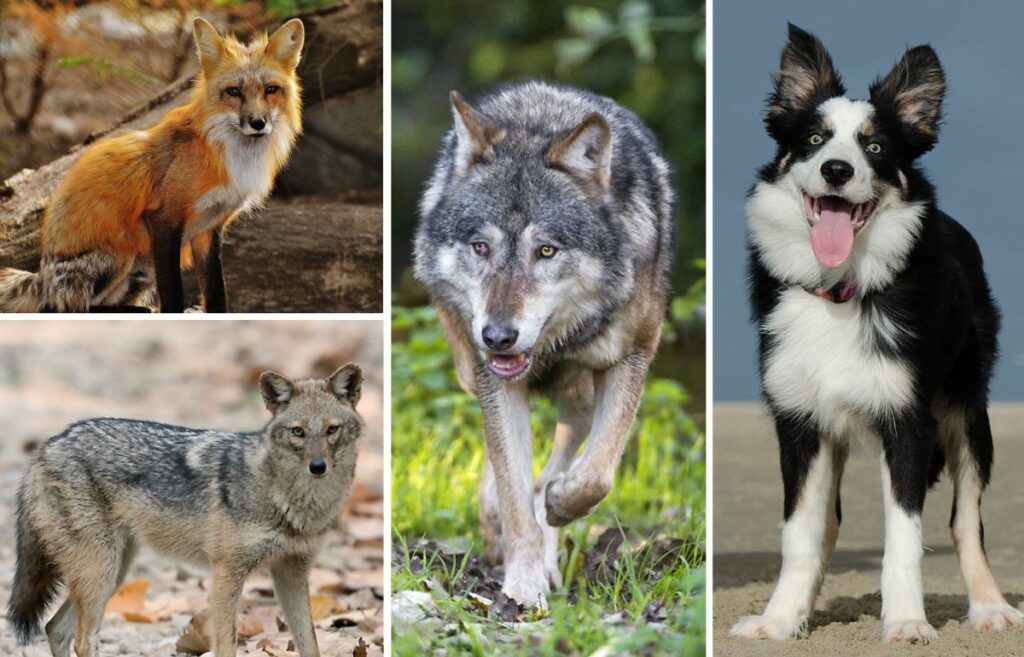
Dogs have been our faithful companions for thousands of years, but their journey from wild wolves to the diverse array of breeds we see today is a fascinating tale of adaptation, selective breeding, and human companionship. From their origins as hunting and guarding partners to the emergence of specialized breeds for various tasks and, more recently, the advent of designer dogs, the evolution of dog breeds reflects both the practical needs and aesthetic preferences of human society.
From Wolves to Domestication:
The story of dog breeds traces back to their wild ancestors, the gray wolves (Canis lupus). Around 15,000 years ago, during the late Paleolithic era, a crucial relationship began to form between humans and wolves. This relationship marked the initial steps towards domestication, ultimately leading to the emergence of the diverse range of dog breeds we know today.
Ancient humans, as hunter-gatherers, were nomadic and relied on various strategies for survival. It’s believed that wolves, being highly social and adaptable predators, began to scavenge around human campsites for food scraps. Over time, some wolves became less fearful of humans, while humans, recognizing the benefits of having these animals around, may have started to tolerate their presence.
This tentative relationship between humans and wolves gradually evolved into a mutually beneficial partnership. Wolves provided invaluable assistance to humans in various aspects of their lives. They served as effective guards, alerting humans to potential dangers from other predators or rival tribes. Additionally, wolves’ keen hunting instincts and cooperation made them valuable allies in hunting expeditions, aiding humans in tracking and capturing prey.
As this symbiotic relationship deepened, certain wolves that exhibited more favorable traits, such as docility, loyalty, and adaptability, would have been favored by humans. Over generations, humans began to selectively breed these wolves, inadvertently shaping their behavior and physical characteristics to better suit human needs and preferences.
The process of domestication involved both intentional selective breeding by humans and natural adaptation by the wolves themselves. Over time, these wolves evolved into the earliest proto-dogs, distinct from their wild ancestors in various ways. They became more attuned to human social cues, developed a greater tolerance for living in close proximity to humans, and displayed behaviors conducive to cooperation and companionship.
This gradual transformation from wild wolves to domesticated dogs laid the foundation for the remarkable diversity of dog breeds we see today. While the exact timeline and mechanisms of domestication are still debated among researchers, the consensus is that the relationship between humans and wolves played a pivotal role in the evolution of dogs. Through millennia of coexistence, selective breeding, and natural adaptation, dogs have become not only our loyal companions but also a testament to the power of interspecies cooperation and mutualism.
Development of Working and Companion Breeds:
As human civilization advanced and societies became more organized, the roles of dogs diversified to meet the needs of their human counterparts. Selective breeding played a crucial role in the development of specialized breeds tailored to specific tasks, ranging from herding and guarding to hunting and companionship.
Working breeds emerged to fulfill essential functions in various human endeavors. These breeds were meticulously bred for traits such as intelligence, strength, agility, and trainability. Among them, the Border Collie stands out as a prime example. Bred primarily for herding livestock, Border Collies possess exceptional intelligence and a natural instinct for gathering and controlling sheep. Their tireless work ethic and ability to respond to subtle commands make them indispensable partners for farmers and ranchers.
Similarly, the German Shepherd has earned a reputation as one of the most versatile and capable working breeds. Originally bred for herding and guarding sheep, German Shepherds excel in a wide range of tasks, including police and military work, search and rescue operations, and service dog roles. Their keen intellect, unwavering loyalty, and courage make them invaluable assets in various fields requiring discipline and reliability.
The Labrador Retriever, another iconic working breed, epitomizes versatility and adaptability. Originally developed as fishing and hunting companions in Newfoundland, Labradors possess a remarkable combination of strength, athleticism, and gentle temperament. Their exceptional retrieving abilities and affable nature have made them indispensable partners for hunters, as well as reliable service dogs and beloved family pets.
In contrast to working breeds, companion breeds were bred primarily for their suitability as household pets. These breeds were often characterized by their small size, gentle demeanor, and affectionate nature, making them ideal companions for families and individuals seeking companionship and affection.
The Pomeranian, with its fluffy coat and vivacious personality, exemplifies the charm and elegance of companion breeds. Originally bred as companions to royalty in Europe, Pomeranians are renowned for their intelligence, extroverted nature, and unwavering loyalty to their owners. Despite their diminutive size, they possess a spirited demeanor and often excel in activities such as agility and obedience trials.
Similarly, the Cavalier King Charles Spaniel and Maltese embody the quintessential traits of companion breeds. Cavaliers are cherished for their friendly disposition, gentle temperament, and affectionate nature, while Maltese are prized for their silky white coats and playful personalities. Both breeds thrive on human companionship and are well-suited to life as cherished family pets.
The development of working and companion breeds reflects the evolving relationship between humans and dogs throughout history. Whether assisting with essential tasks or providing companionship and comfort, these breeds have become integral members of human society, enriching our lives with their loyalty, dedication, and unwavering affection.
Rise of Purebred Standards:
The 19th century marked a significant turning point in the history of dog breeding, characterized by the rise of purebred standards and the establishment of kennel clubs. This era witnessed a shift towards more standardized practices, with a focus on defining and preserving the physical and behavioral characteristics of specific dog breeds.
The proliferation of kennel clubs, such as the Kennel Club in the United Kingdom and the American Kennel Club in the United States, played a pivotal role in shaping the direction of dog breeding. These organizations were founded with the primary purpose of promoting and regulating purebred dog breeds. They established breed registries, maintained pedigrees, and developed breed standards that outlined the ideal traits and conformation for each breed.
Breed standards served as comprehensive guidelines that defined the desired physical attributes, temperament, and behavior of each breed. These standards were meticulously crafted based on the historical lineage, function, and distinctive characteristics of each breed. For example, the breed standard for the German Shepherd would emphasize traits such as strength, agility, and intelligence, reflecting the breed’s origins as a versatile working dog.
The classification of dogs into distinct breeds based on lineage and conformation became a defining feature of this era. Breeders meticulously selected breeding stock with the aim of perpetuating and refining specific breed traits, such as coat color, size, ear shape, and tail carriage. This emphasis on maintaining breed purity and adhering to established standards led to the codification of breed characteristics and the preservation of breed integrity.
The emergence of prestigious dog shows further reinforced the importance of breed standards in shaping the direction of breed development. These shows provided a platform for breeders to showcase their dogs and demonstrate their adherence to established standards. Judges, selected for their expertise and knowledge of breed standards, evaluated dogs based on their conformation, movement, and overall adherence to breed type.
Winning dogs at these shows gained recognition and prestige, contributing to their status as desirable breeding stock. As a result, breeders focused on producing dogs that epitomized the ideal breed standard, further refining and homogenizing breed characteristics over time.
However, while the establishment of purebred standards brought about greater uniformity and predictability in dog breeding, it also led to concerns about the potential negative consequences of excessive inbreeding and the perpetuation of genetic disorders within certain breeds. Nonetheless, the rise of purebred standards laid the foundation for the modern dog fancy and continues to influence contemporary dog breeding practices.
The Era of Designer Dogs:
In recent years, the emergence of designer dogs has captured the attention of dog enthusiasts worldwide. Designer dogs, also known as hybrid dogs or crossbreeds, are the result of intentionally crossing two purebred breeds to create offspring that exhibit desirable traits from both parent breeds. This trend has gained popularity as people seek out dogs with specific characteristics, such as hypoallergenic coats, intelligence, and temperament, that may not be present in traditional purebred breeds alone.
One of the most well-known examples of designer dogs is the Labradoodle, a cross between a Labrador Retriever and a Poodle. Labradoodles were initially bred in the 1980s with the aim of combining the Labrador’s friendly demeanor and trainability with the Poodle’s hypoallergenic coat and intelligence. Similarly, the Goldendoodle, a cross between a Golden Retriever and a Poodle, has gained popularity for its gentle nature, intelligence, and low-shedding coat.
Proponents of designer dogs argue that they offer a unique blend of desirable traits from their parent breeds, making them well-suited for a wide range of lifestyles and preferences. For example, Labradoodles and Goldendoodles are often praised for their hypoallergenic coats, making them suitable companions for individuals with allergies to pet dander. Additionally, their intelligence, trainability, and friendly disposition make them popular choices for families, therapy work, and service dog roles.
However, the rise of designer dogs has also sparked debate and controversy within the dog breeding community. Critics raise concerns about the ethics and potential health issues associated with crossbreeding. Unlike purebred dogs, whose traits are relatively predictable due to generations of selective breeding within a closed gene pool, designer dogs inherit a diverse mix of genes from their parent breeds. This genetic variability can result in unpredictable outcomes in terms of appearance, temperament, and health.
One of the primary concerns surrounding designer dogs is the risk of inherited genetic disorders and health problems associated with hybrid vigor. While crossbreeding can potentially reduce the incidence of certain breed-specific health issues present in purebred dogs, it can also introduce new health challenges or exacerbate existing ones. Without careful breeding practices and health screening of parent dogs, designer dogs may be predisposed to a range of genetic conditions, including hip dysplasia, heart disease, and various inheritable disorders.
Furthermore, critics argue that the demand for designer dogs has led to the proliferation of irresponsible breeding practices and the exploitation of popular trends for financial gain. Some breeders may prioritize profit over the welfare of their dogs, leading to the proliferation of puppy mills, where dogs are often kept in deplorable conditions and subjected to poor breeding practices.
Conclusion:
The evolution of dog breeds from their wolf ancestors to the diverse array of breeds we see today reflects the intertwined relationship between humans and dogs throughout history. From their roles as working partners to beloved companions, dogs have adapted to meet the changing needs and preferences of human society. Whether purebred or designer, each dog breed carries a rich heritage and a unique story that continues to captivate dog lovers around the world.
 Introducing the Adorable Pomapoo: A Perfect Blend of Poodle and Pomeranian!
Introducing the Adorable Pomapoo: A Perfect Blend of Poodle and Pomeranian!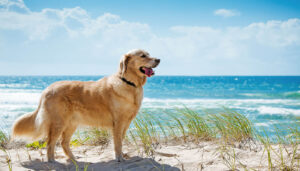 Golden Retrievers: The Heartwarming Companions You’ll Never Forget
Golden Retrievers: The Heartwarming Companions You’ll Never Forget The Labrador Retriever: A Timeless Companion of Joy and Loyalty
The Labrador Retriever: A Timeless Companion of Joy and Loyalty The Sheprador: A Loyal and Energetic Blend of Intelligence and Affection
The Sheprador: A Loyal and Energetic Blend of Intelligence and Affection Bichon Poo: The Ultimate Guide to This Charming Poodle and Bichon Frise Mix
Bichon Poo: The Ultimate Guide to This Charming Poodle and Bichon Frise Mix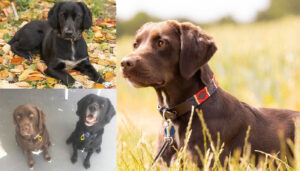 Springador Dog: Discover the Perfect Blend of Labrador Retriever and English Springer Spaniel
Springador Dog: Discover the Perfect Blend of Labrador Retriever and English Springer Spaniel Corgidor: The Perfect Blend of Labrador Retriever and Corgi
Corgidor: The Perfect Blend of Labrador Retriever and Corgi The Goldador: Where Labrador and Golden Retriever Meet
The Goldador: Where Labrador and Golden Retriever Meet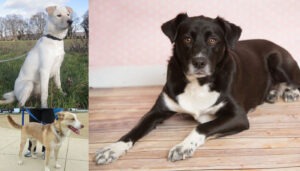 The Huskador: An Enchanting Blend of Husky Spirit and Labrador Loyalty
The Huskador: An Enchanting Blend of Husky Spirit and Labrador Loyalty Labloodhound: A Perfect Blend of Playfulness and Tracking Instincts
Labloodhound: A Perfect Blend of Playfulness and Tracking Instincts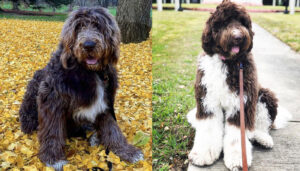 Newfypoo: The Ultimate Guide to Poodle and Newfoundland Mix Breed
Newfypoo: The Ultimate Guide to Poodle and Newfoundland Mix Breed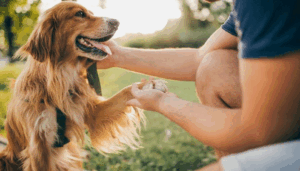 The Science Behind Dog Cognition: Understanding How Your Pup Thinks
The Science Behind Dog Cognition: Understanding How Your Pup Thinks